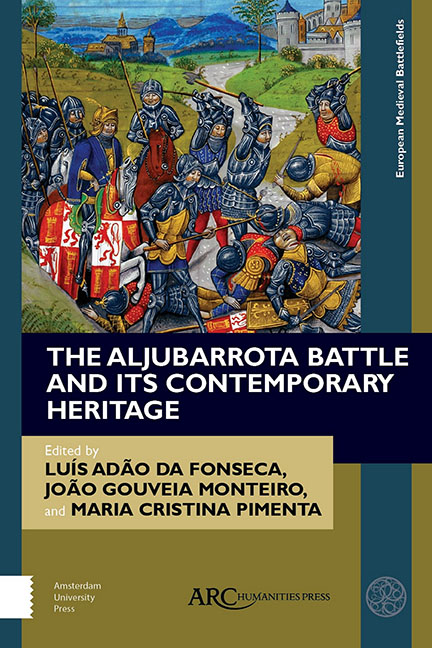Book contents
- Frontmatter
- Contents
- List of Illustrations
- Introduction
- Chapter 1 Before Aljubarrota
- Chapter 2 Fighting a Battle in the Middle Ages
- Chapter 3 The Decision to Fight at Aljubarrota
- Chapter 4 The Decisive Battle
- Chapter 5 Casualties and the Aftermath
- Chapter 6 Contemporary Memory and Myth-Making
- Chapter 7 The Legacy for Later Memories
- Chapter 8 The Battle of Aljubarrota Interpretation Centres
- Select Bibliography
- Index
Chapter 4 - The Decisive Battle
Published online by Cambridge University Press: 20 November 2020
- Frontmatter
- Contents
- List of Illustrations
- Introduction
- Chapter 1 Before Aljubarrota
- Chapter 2 Fighting a Battle in the Middle Ages
- Chapter 3 The Decision to Fight at Aljubarrota
- Chapter 4 The Decisive Battle
- Chapter 5 Casualties and the Aftermath
- Chapter 6 Contemporary Memory and Myth-Making
- Chapter 7 The Legacy for Later Memories
- Chapter 8 The Battle of Aljubarrota Interpretation Centres
- Select Bibliography
- Index
Summary
LET US CONSIDER first what sources are available for reconstructing the Battle of Aljubarrota. As well as the extensive account given by the greatest Portuguese chronicler, Fernão Lopes, the work of two other important chroniclers is available—the previously cited Pero López de Ayala, chancellor of the Castilian king and eye witness at the battle; and Jean Froissart, a French chronicler, who was familiar with English military culture and author of two previously cited accounts of the battle, based upon interviews conducted at the end of 1388 and beginning of 1389 (in Orthez) and at the end of 1389 or beginning of 1390 (in Middelburg). A description of the battle forms part of the anonymous text Crónica do Condestabre, written between 1431 and 1437 and which recounts the life of Nuno Álvares Pereira. Also the Sumario de los Reyes de España, prepared by Juan Rodríguez de Cuenca, the head purveyor of Juan I's first wife and which, through a mysterious hand, added between 1456 and 1460, provides reference to the battle. Then we still have a valuable letter written in Seville on August 29, 1385, by Juan I, to the city of Murcia, in which he provides an account of what happened in the battle.
But we have physical remains too. There is a chapel on the battlefield itself, initially with the Virgin Mary and later St. George as its patron saint, which Nuno Álvares Pereira had built in 1393. This has a genuine engraved stone which announces that, on the day of the battle, the Constable's flag (i.e., the vanguard of the army) was positioned at that very spot.
Archaeological work carried out at São Jorge between 1958 and 1960 by Afonso do Paço, reassessed in 1985 by Severino Lourenço, and continued in 1999 by Helena Catarino on a different part of the terrain, supplements our knowledge. More recently, Maria Antónia Athayde Amaral, as part of the excavations prior to the extension of the Military Museum on the battlefield (now the Centre for Interpretation of the Battle of Aljubarrota), found a new ditch, located in the area which presumably corresponds to the approximate position of the Anglo-Portuguese rear-guard.
- Type
- Chapter
- Information
- Aljubarrota Battle and Its Contemporary Heritage , pp. 47 - 66Publisher: Amsterdam University PressPrint publication year: 2020



